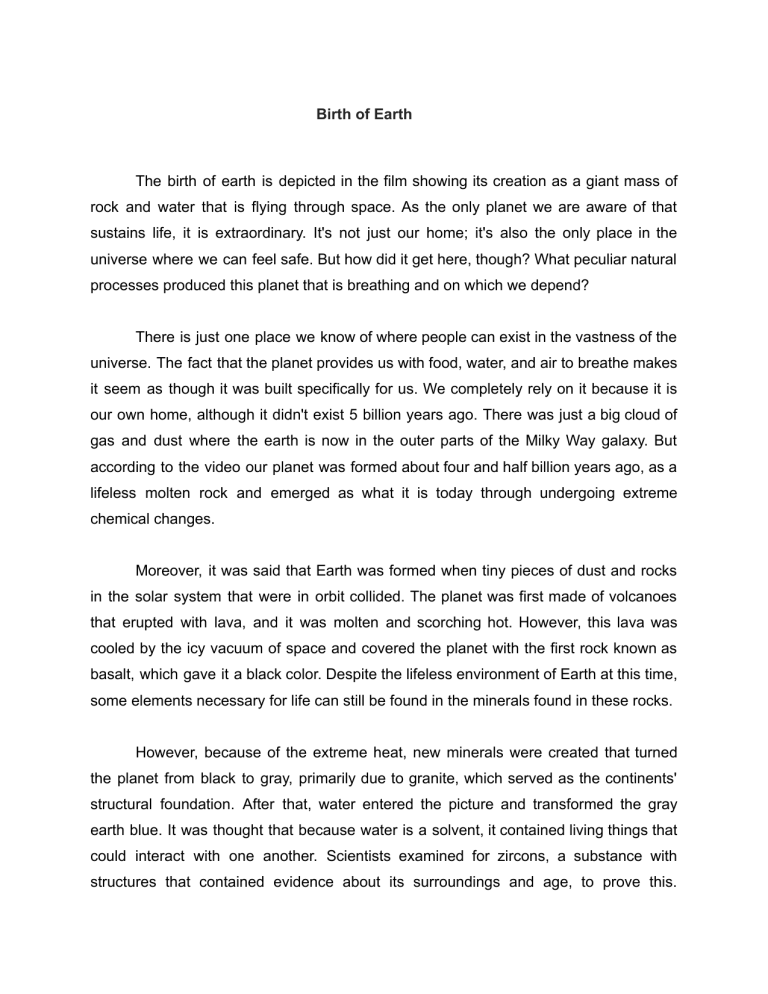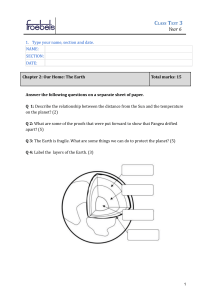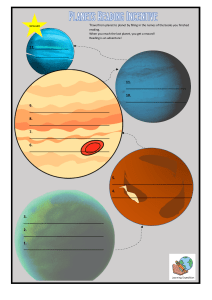
Birth of Earth The birth of earth is depicted in the film showing its creation as a giant mass of rock and water that is flying through space. As the only planet we are aware of that sustains life, it is extraordinary. It's not just our home; it's also the only place in the universe where we can feel safe. But how did it get here, though? What peculiar natural processes produced this planet that is breathing and on which we depend? There is just one place we know of where people can exist in the vastness of the universe. The fact that the planet provides us with food, water, and air to breathe makes it seem as though it was built specifically for us. We completely rely on it because it is our own home, although it didn't exist 5 billion years ago. There was just a big cloud of gas and dust where the earth is now in the outer parts of the Milky Way galaxy. But according to the video our planet was formed about four and half billion years ago, as a lifeless molten rock and emerged as what it is today through undergoing extreme chemical changes. Moreover, it was said that Earth was formed when tiny pieces of dust and rocks in the solar system that were in orbit collided. The planet was first made of volcanoes that erupted with lava, and it was molten and scorching hot. However, this lava was cooled by the icy vacuum of space and covered the planet with the first rock known as basalt, which gave it a black color. Despite the lifeless environment of Earth at this time, some elements necessary for life can still be found in the minerals found in these rocks. However, because of the extreme heat, new minerals were created that turned the planet from black to gray, primarily due to granite, which served as the continents' structural foundation. After that, water entered the picture and transformed the gray earth blue. It was thought that because water is a solvent, it contained living things that could interact with one another. Scientists examined for zircons, a substance with structures that contained evidence about its surroundings and age, to prove this. Zircons, which can only form in the presence of liquid water, were found in old rocks, revealing that the earth was once a habitable planet. Furthermore, the top layer of stromatolites, the earliest evidence of life, has bacteria that draw minerals and sand from water and solidify them. Through photosynthesis, the bacteria in the stromatolites derived their energy from the sun. These chemical reactions leave behind chemical traces that result in the creation of oxygen. The planet turned red when the iron in the early oceans reacted with oxygen to make rust, which then sank to the bottom of the sea. And once again, as a result of these interactions, new minerals were produced that eventually formed new continents and brought about climate change. The earth turned freezing white, killing off most life. Eventually, the ice was melted by the heat the volcanoes produced. About 540 million years ago, when the ice melted, the planet became green and habitat to fascinating animals and plants that survived by being the fittest. Survival of the fittest becomes the usual in a different setting. The theory that microbial life helped give birth to hundreds of minerals and organisms and that rocks and life have an intertwined history was validated by the data gathered by some scientists and other life research specialists, but will still remain an enormous mystery that needs to be solved.





